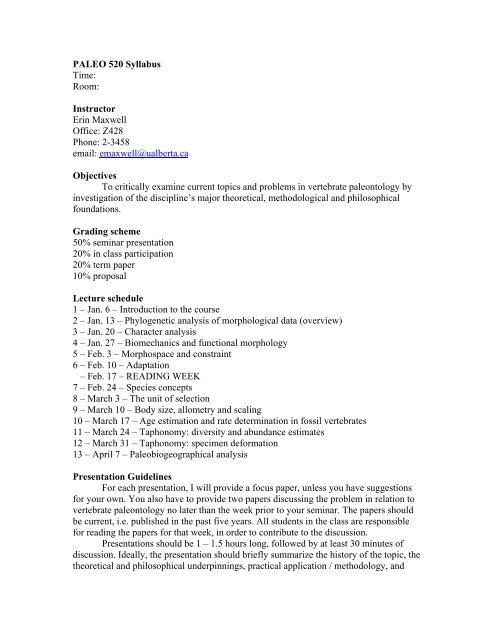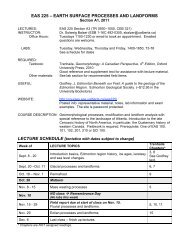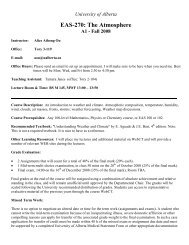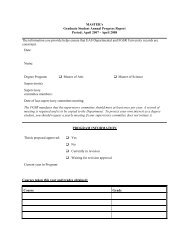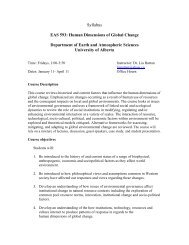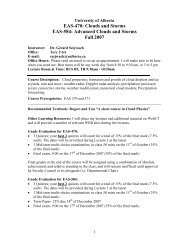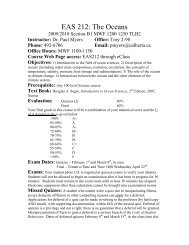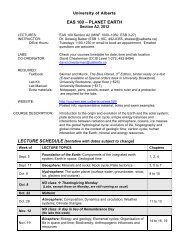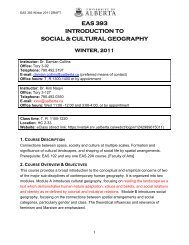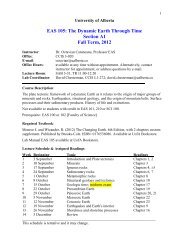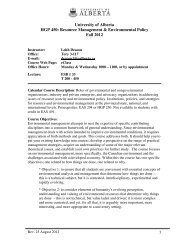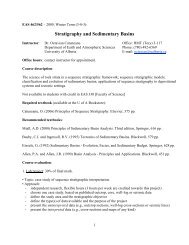PALEO 520 Syllabus Time: Room: Instructor Erin Maxwell Office ...
PALEO 520 Syllabus Time: Room: Instructor Erin Maxwell Office ...
PALEO 520 Syllabus Time: Room: Instructor Erin Maxwell Office ...
You also want an ePaper? Increase the reach of your titles
YUMPU automatically turns print PDFs into web optimized ePapers that Google loves.
<strong>PALEO</strong> <strong>520</strong> <strong>Syllabus</strong><br />
<strong>Time</strong>:<br />
<strong>Room</strong>:<br />
<strong>Instructor</strong><br />
<strong>Erin</strong> <strong>Maxwell</strong><br />
<strong>Office</strong>: Z428<br />
Phone: 2-3458<br />
email: emaxwell@ualberta.ca<br />
Objectives<br />
To critically examine current topics and problems in vertebrate paleontology by<br />
investigation of the discipline’s major theoretical, methodological and philosophical<br />
foundations.<br />
Grading scheme<br />
50% seminar presentation<br />
20% in class participation<br />
20% term paper<br />
10% proposal<br />
Lecture schedule<br />
1 – Jan. 6 – Introduction to the course<br />
2 – Jan. 13 – Phylogenetic analysis of morphological data (overview)<br />
3 – Jan. 20 – Character analysis<br />
4 – Jan. 27 – Biomechanics and functional morphology<br />
5 – Feb. 3 – Morphospace and constraint<br />
6 – Feb. 10 – Adaptation<br />
– Feb. 17 – READING WEEK<br />
7 – Feb. 24 – Species concepts<br />
8 – March 3 – The unit of selection<br />
9 – March 10 – Body size, allometry and scaling<br />
10 – March 17 – Age estimation and rate determination in fossil vertebrates<br />
11 – March 24 – Taphonomy: diversity and abundance estimates<br />
12 – March 31 – Taphonomy: specimen deformation<br />
13 – April 7 – Paleobiogeographical analysis<br />
Presentation Guidelines<br />
For each presentation, I will provide a focus paper, unless you have suggestions<br />
for your own. You also have to provide two papers discussing the problem in relation to<br />
vertebrate paleontology no later than the week prior to your seminar. The papers should<br />
be current, i.e. published in the past five years. All students in the class are responsible<br />
for reading the papers for that week, in order to contribute to the discussion.<br />
Presentations should be 1 – 1.5 hours long, followed by at least 30 minutes of<br />
discussion. Ideally, the presentation should briefly summarize the history of the topic, the<br />
theoretical and philosophical underpinnings, practical application / methodology, and
data (if relevant). The presenter should be prepared to provide a few points for<br />
discussion. Presentations should be formal (i.e., powerpoint or other visual aids); I will<br />
organize a projector.<br />
Term paper and abstract guidelines<br />
Your term paper should be 20-30 pages long (including references). It should be<br />
a literature review discussing either a theoretical problem in vertebrate paleontology (for<br />
instance, “Can we identify ‘ancestors’ in the fossil record?”), or a critical evaluation of a<br />
set of methodologies (example: “Methods for estimating time of origin of a clade”). If the<br />
latter approach is selected, strengths and weaknesses of the chosen methodologies as well<br />
as potential alternate methods need to be discussed. The paper can also take the form of a<br />
test of the different methods on a sample data set. Your presentation and your paper<br />
should not overlap. The term paper is due (in hard copy) April 9 th .<br />
Please hand in a 1-page proposal (single-spaced) including at least four references<br />
for your term paper by February 12 th . The proposal should include the following details:<br />
1) Topic (what is the problem to be investigated? Why is it of interest?); 2) Background<br />
(quick summary of existing literature conflict) 3) Objectives (how you plan on<br />
approaching the problem – non-biased summary? Point-of-view piece? With data?). The<br />
proposal is binding, in the sense that if your term paper is on a different topic than that<br />
outlined in the proposal, you may be penalized. If you really need to switch topics, come<br />
talk to me no less than one week before the term paper is due and provide me with a new<br />
proposal. The new proposal will be regraded. I reserve the right to refuse the topic switch.<br />
Focus papers<br />
Phylogenetic analysis of morphological data: Folinsbee, K.E., D.C. Evans, J. Fröbisch,<br />
L.A. Tsuji and D.R. Brooks. 2007. Quantitative approaches to phylogenetics. In<br />
Handbook of Paleoanthropology pp. 67-215.<br />
Character analysis: Poe, S. and J.J. Wiens. Character selection and the methodology of<br />
morphological phylogenetics. In J.J. Wiens (ed.), Phylogenetic analysis of morphological<br />
data. Smithsonian Institution Press, Washington. pp. 20-36.<br />
Biomechanics and functional morphology: Koehl, M.A.R. 1996. When does morphology<br />
matter? Annual review of Ecology and Systematics 27:501-542.<br />
Morphospace and constraint: Richardson, M.K. and A.D. Chipman. 2003.<br />
Developmental constraints in a comparative framework: a test case using variations in<br />
phalanx number during amniote evolution. Journal of Experimental Zoology (Mol Dev<br />
Evol) 296B:8-22.<br />
Adaptation: Baum, D.A., and A. Larson. 1991. Adaptation reviewed: a phylogenetic<br />
methodology for studying character macroevolution. Systematic Zoology 40(1):1-18.<br />
Species concepts: de Queiroz, K. 2007. Species concepts and species delimitation.<br />
Systematic Biology 56(6):879-886.
The unit of selection: Jablonski, D. 2008. Species selection: theory and data. Annual<br />
Reviews of Ecology, Evolution and Systematics 39:501-524.<br />
Body size, allometry and scaling: LaBarbera, M. 1989. Analyzing body size as a factor in<br />
ecology and evolution. Annual Review of Ecology and Systematics 20:97-117.<br />
Age estimation and rate determination in fossil vertebrates: Castanet, J., H. Francillon-<br />
Vieillot, F.J. Meunier, and A. de Ricqles. 1993. Bone and individual aging. In B.K. Hall,<br />
(ed.) Bone, Volume 7: Bone Growth B.<br />
Taphonomy: diversity and abundance estimates: Behrensmeyer, A.K., S.M. Kidwell and<br />
R.A. Gastaldo. 2000. Taphonomy and paleobiology. Paleobiology 26(4,<br />
supplement):103-147.<br />
Taphonomy, deformation and reconstruction: Boyd, A.A. and R. Motani. 2008. Threedimensional<br />
re-evaluation of the deformation removal technique based on “jigsaw<br />
puzzling”. Palaeontologia Electronica 11(2):7A<br />
Paleobiogeographical analysis: Morrone, J.J. and J.V. Crisci. 1995. Historical<br />
biogeography: introduction to methods. Annual Review of Ecology and Systematics<br />
26:373-401.


